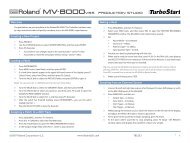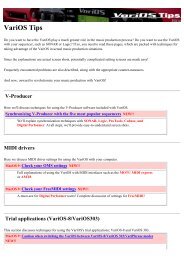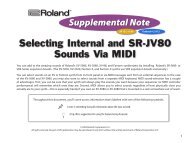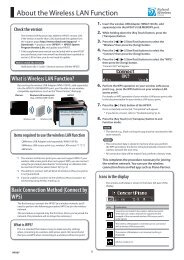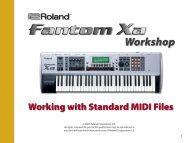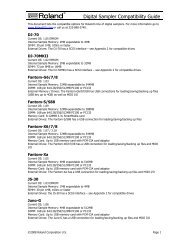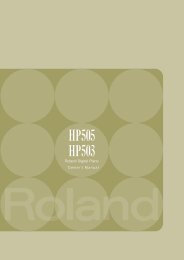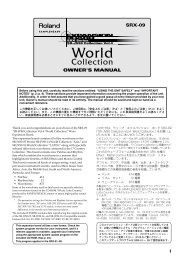Roland GW-7 MIDI Implementation
Roland GW-7 MIDI Implementation
Roland GW-7 MIDI Implementation
Create successful ePaper yourself
Turn your PDF publications into a flip-book with our unique Google optimized e-Paper software.
<strong>Roland</strong> <strong>GW</strong>-7 <strong>MIDI</strong> <strong>Implementation</strong><br />
(B3) 64 7F (<strong>MIDI</strong> ch.4) lower byte of RPN parameter number: 7FH<br />
(B3) 65 7F (<strong>MIDI</strong> ch.4) upper byte of RPN parameter number: 7FH<br />
In other words, the above messages specify a value of 0C 00H for RPN parameter number<br />
00 00H on <strong>MIDI</strong> channel 4, and then set the RPN parameter number to 7F 7FH.<br />
RPN parameter number 00 00H is Pitch Bend Sensitivity, and the MSB of the value indicates<br />
semitone units, so a value of 0CH = 12 sets the maximum pitch bend range to +/-12<br />
semitones (1 octave). (On GS sound generators the LSB of Pitch Bend Sensitivity is ignored,<br />
but the LSB should be transmitted anyway (with a value of 0) so that operation will be<br />
correct on any device.)<br />
Once the parameter number has been specified for RPN or NRPN, all Data Entry messages<br />
transmitted on that same channel will be valid, so after the desired value has been<br />
transmitted, it is a good idea to set the parameter number to 7F 7FH to prevent accidents.<br />
This is the reason for the (B3) 64 7F (B3) 65 7F at the end.<br />
It is not desirable for performance data (such as Standard <strong>MIDI</strong> File data) to contain many<br />
events with running status as given in [Example 4]. This is because if playback is halted<br />
during the song and then rewound or fast-forwarded, the sequencer may not be able to<br />
transmit the correct status, and the sound generator will then misinterpret the data. Take<br />
care to give each event its own status.<br />
It is also necessary that the RPN or NRPN parameter number setting and the value setting<br />
be done in the proper order. On some sequencers, events occurring in the same (or<br />
consecutive) clock may be transmitted in an order different than the order in which they<br />
were received. For this reason it is a good idea to slightly skew the time of each event (about<br />
1 tick for TPQN = 96, and about 5 ticks for TPQN = 480).<br />
* TPQN: Ticks Per Quarter Note<br />
■Example of an Exclusive message and<br />
calculating a checksum<br />
<strong>Roland</strong> Exclusive messages (RQ1, DT1) are transmitted with a checksum at the end (before<br />
F7) to make sure that the message was correctly received. The value of the checksum is<br />
determined by the address and data (or size) of the transmitted Exclusive message.<br />
❍How to calculate the checksum (hexadecimal numbers are indicated by<br />
“H”)<br />
The checksum is a value derived by adding the address, size, and checksum itself and<br />
inverting the lower 7 bits.<br />
Here’s an example of how the checksum is calculated. We will assume that in the Exclusive<br />
message we are transmitting, the address is aa bb ccH and the data or size is dd ee ffH.<br />
aa+bb+cc+dd+ee+ff = sum<br />
sum ÷ 128 = quotient ... remainder<br />
128 - remainder = checksum<br />
[Example 1] Setting REVERB MACRO to ROOM 3<br />
According to the “Parameter Address Map,” the REVERB MACRO Address is 40 01 30H,<br />
and ROOM 3 is a value of 02H. Thus:<br />
F0 41 10 42 12 40 01 30 02 ?? F7<br />
(1) (2) (3) (4) (5) address data checksum (6)<br />
(1) Exclusive Status, (2) ID (<strong>Roland</strong>), (3) Device ID (17),<br />
(4) Model ID (GS), (5) Command ID (DT1), (6) End of Exclusive<br />
Next, we calculate the checksum.<br />
40H + 01H + 30H + 02H = 64 + 1 + 48 + 2 = 115 (sum)<br />
115 (sum) ÷ 128 = 0 (quotient) ... 115 (remainder)<br />
checksum = 128 - 115 (remainder) = 13 = 0DH<br />
This means that F0 41 10 42 12 40 01 30 02 0D F7 is the message we transmit.<br />
[Example 2] Setting REVERB LEVEL to 12<br />
According to the “Parameter Address Map,” the REVERB LEVEL Address is 40 01 33H, and<br />
the parameter value is 0CH. Thus:<br />
F0 41 10 42 12 40 01 33 0C ?? F7<br />
(1) (2) (3) (4) (5) address data checksum (6)<br />
(1) Exclusive Status, (2) ID (<strong>Roland</strong>), (3) Device ID (17),<br />
(4) Model ID (GS), (5) Command ID (DT1), (6) End of Exclusive<br />
Next, we calculate the checksum.<br />
40H + 01H + 33H + 0CH = 64 + 1 + 51 + 12 = 128 (sum)<br />
128 (sum) ÷ 128 = 0 (quotient) ... 0 (remainder)<br />
checksum = 128 - 0 (remainder) = 128 = 80H<br />
In this case, however, the checksum value should be 00H, not 80H. You should use 00H if<br />
the remainder is 0.<br />
This means that F0 41 10 42 12 40 01 33 0C 00 F7 is the message we transmit.<br />
■About the Tuning<br />
In <strong>MIDI</strong>, individual Parts are tuned by sending RPN #1 (Channel Fine Tuning) to the<br />
appropriate <strong>MIDI</strong> channel.<br />
In <strong>MIDI</strong>, an entire device is tuned by either sending RPN #1 to all <strong>MIDI</strong> channels being<br />
used, or by sending a System Exclusive MASTER TUNE (address 40 00 00H).<br />
RPN #1 allows tuning to be specified in steps of approximately 0.012 cents (to be precise,<br />
100/8192 cent), and System Exclusive MASTER TUNE allows tuning in steps of 0.1 cent.<br />
One cent is 1/100th of a semitone.<br />
The values of RPN #1 (Channel Fine Tuning) and System Exclusive MASTER TUNE are<br />
added together to determine the actual pitch sounded by each Part.<br />
Frequently used tuning values are given in the following table for your reference. Values<br />
are in hexadecimal (decimal in parentheses).<br />
+————————+————————+——————————————+———————————————————+<br />
|Hz at A4| Cents | RPN #1 | Sys.Ex. 40 00 00 |<br />
+————————+————————+——————————————+———————————————————+<br />
| 445.0 | +19.56 | 4C 43 (+1603)| 00 04 0C 04 (+196)|<br />
| 444.0 | +15.67 | 4A 03 (+1283)| 00 04 09 0D (+157)|<br />
| 443.0 | +11.76 | 47 44 (+964) | 00 04 07 06 (+118)|<br />
| 442.0 | + 7.85 | 45 03 (+643) | 00 04 04 0F (+79) |<br />
| 441.0 | + 3.93 | 42 42 (+322) | 00 04 02 07 (+39) |<br />
| 440.0 | 0 | 40 00 (0) | 00 04 00 00 (0) |<br />
| 439.0 | — 3.94 | 3D 3D (—323) | 00 03 0D 09 (—39) |<br />
| 438.0 | — 7.89 | 3A 7A (—646) | 00 03 0B 01 (—79) |<br />
+————————+————————+——————————————+———————————————————+<br />
[Example] Setting the tuning of <strong>MIDI</strong> channel 3 to A4 = 442.0 Hz<br />
Send RPN#1 to <strong>MIDI</strong> channel 3. From the above table, the value is 45 03H.<br />
B2 64 01 <strong>MIDI</strong> ch.3, lower byte of RPN parameter number: 01H<br />
(B2) 65 00 (<strong>MIDI</strong> ch.3) upper byte of RPN parameter number: 00H<br />
(B2) 06 45 (<strong>MIDI</strong> ch.3) upper byte of parameter value: 45H<br />
(B2) 26 03 (<strong>MIDI</strong> ch.3) lower byte of parameter value: 03H<br />
(B2) 64 7F (<strong>MIDI</strong> ch.3) lower byte of RPN parameter number: 7FH<br />
(B2) 65 7F (<strong>MIDI</strong> ch.3) upper byte of RPN parameter number: 7FH<br />
●The Scale Tune Feature (address: 40 1x 40)<br />
The scale Tune feature allows you to finely adjust the individual pitch of the notes from C<br />
through B. Though the settings are made while working with one octave, the fine<br />
adjustments will affect all octaves. By making the appropriate Scale Tune settings, you can<br />
obtain a complete variety of tuning methods other than equal temperament. As examples,<br />
three possible types of scale setting are explained below.<br />
❍Equal Temperament<br />
This method of tuning divides the octave into 12 equal parts. It is currently the most widely<br />
used form of tuning, especially in occidental music. On the <strong>GW</strong>-7, the default settings for<br />
the Scale Tune feature produce equal temperament.<br />
❍Just Temperament (Tonic of C)<br />
The principal triads resound much more beautifully than with equal temperament, but this<br />
benefit can only be obtained in one key. If transposed, the chords tend to become<br />
ambiguous. The example given involves settings for a key in which C is the keynote.<br />
❍Arabic Scale<br />
By altering the setting for Scale Tune, you can obtain a variety of other tunings suited for<br />
ethnic music. For example, the settings introduced below will set the unit to use the Arabic<br />
Scale.<br />
Example Settings<br />
Note Name Equal Temperament Just Temperament (Keytone C) Arabic Scale<br />
C 0 0 -6<br />
C# 0 -8 +45<br />
D 0 +4 -2<br />
D# 0 +16 -12<br />
E 0 -14 -51<br />
F 0 -2 -8<br />
F# 0 -10 +43<br />
G 0 +2 -4<br />
G# 0 +14 +47<br />
19





